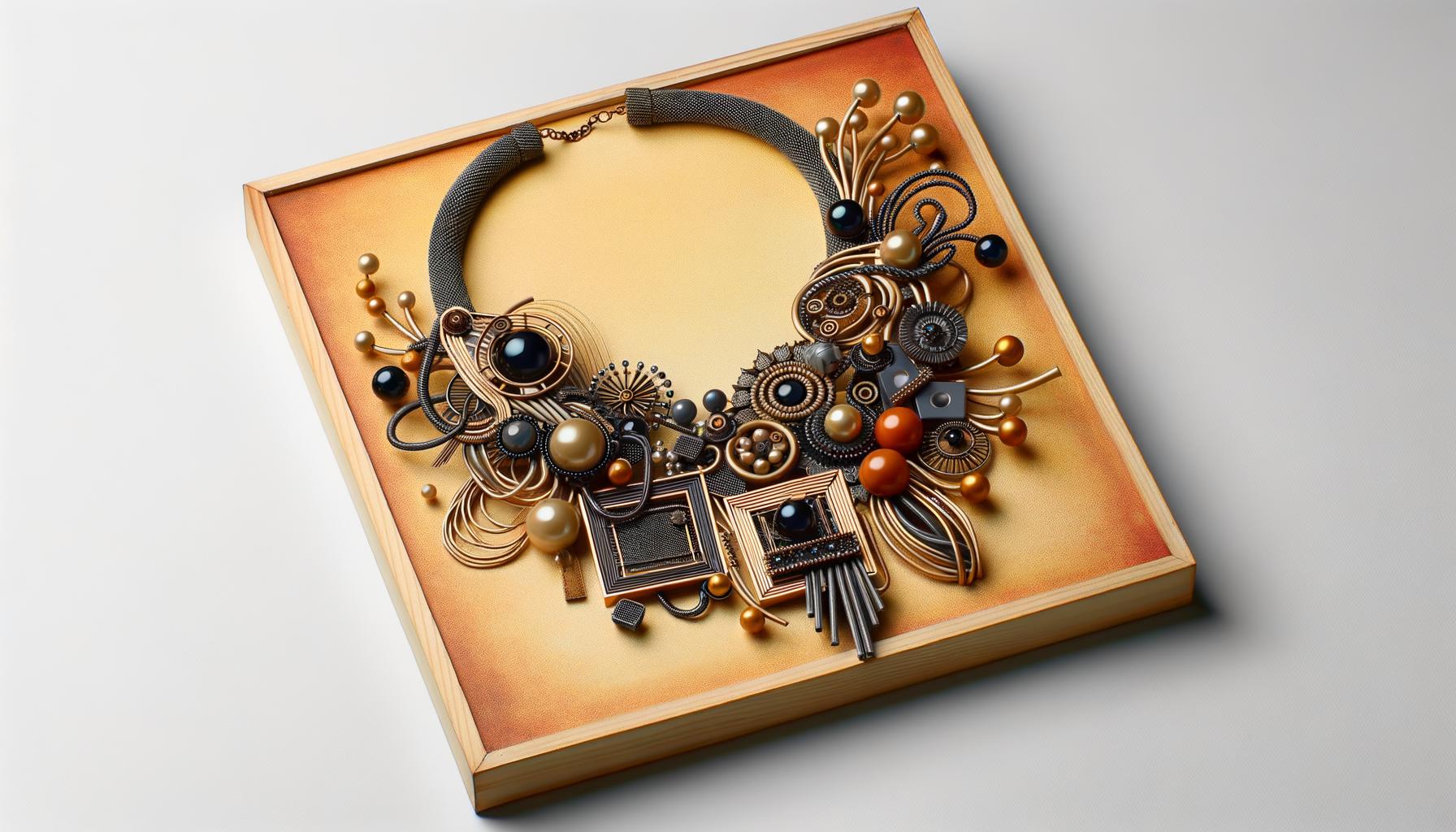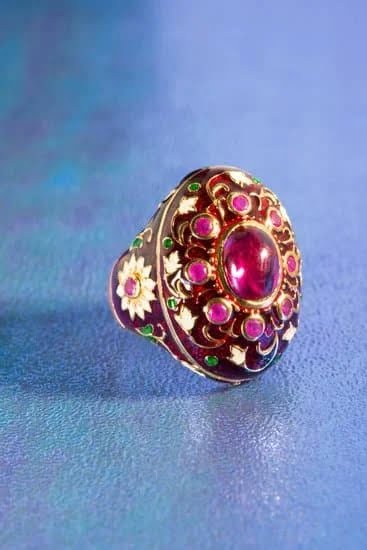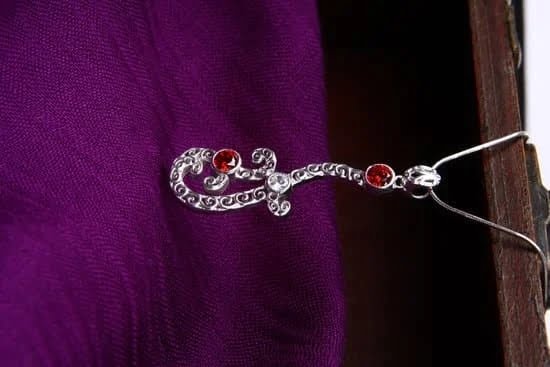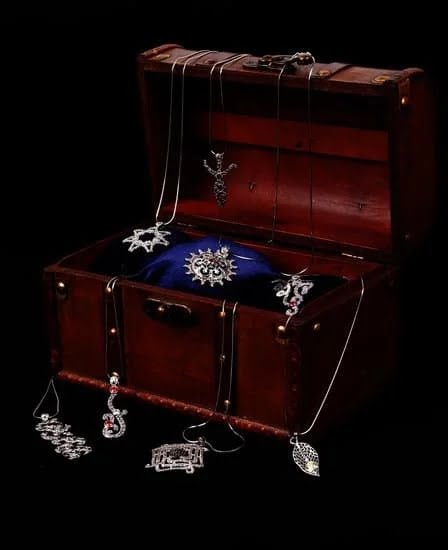Avant-garde jewelry: breaking boundaries in design, represents a revolutionary shift within the jewelry industry, transforming traditional concepts into bold and unorthodox creations. Originating from the broader avant-garde movement in visual arts of the early 20th century, this niche has steadily made its mark by challenging established norms and setting new standards for innovation and creativity.
Unlike conventional jewelry, which often focuses on familiar aesthetics and functionality, avant-garde jewelry prioritizes artistic expression, pushing the limits of what is possible in both form and substance.
The history of avant-garde’s influence on design is rich and storied, beginning with trailblasting artists who sought to dismantle preconceived notions of art. Borrowing from this radical spirit, avant-garde jewelry emerged as a parallel force dedicated to redefining personal adornment.
What sets these pieces apart is their conceptual freedom; they are not just accessories but statements that provoke thought and elicit strong emotions. Whether through unconventional materials like industrial metals or through groundbreaking techniques such as 3D printing and mixed media applications, avant-garde jewelry constantly pushes boundaries.
In an industry historically anchored in tradition and repetition, the importance of innovation cannot be overstated. Avant-garde jewelers thrive on risk-taking and are willing to challenge societal norms to spark conversation and change.
Their work underscores a crucial philosophy: that jewelry can be much more than mere ornamentation-it can be an art form that reflects contemporary culture while paving the way for future trends. This dedication to breaking norms has allowed avant-garde jewelry to evolve into a dynamic sector where creativity knows no bounds.
The Philosophy Behind Avant-Garde Jewelry
The avant-garde movement, traditionally rooted in the visual arts, disrupts conventional norms and established boundaries through innovative, often radical, concepts. In jewelry design, this philosophy translates into pieces that defy traditional aesthetics and functional expectations. Avant-garde jewelry: breaking boundaries in design reflects a deeper connection to the ideologies of transgression and subversion prevalent in avant-garde art forms, repurposing them to fit an ornamental yet equally revolutionary niche.
Central to the philosophy behind avant-garde jewelry is the pursuit of innovation. Designers are not merely creating accessories; they are pushing the limits of what materials can be used and how they can be manipulated. This movement embraces risk-taking with audacious designs that may incorporate unusual materials such as recycled plastics or industrial metals.
Avant-garde jewelers apply cutting-edge techniques-such as 3D printing and laser cutting-to craft intricate, non-traditional shapes that challenge our perceptions of wearability and art. This dedication to new methods ensures each piece is distinctive and thought-provoking.
Another significant aspect of avant-garde jewelry is its role in challenging societal norms and conventions. These pieces often carry profound statements about modern culture, politics, or social issues. They serve as a form of silent protest or advocacy in wearable form. For example:
- Some designs address environmental concerns by using sustainable or reclaimed materials.
- Others make bold political statements with symbols or text embedded within the piece.
- Social critiques might include themes around consumerism, identity, or body image.
By embodying these principles, avant-garde jewelry not only ornaments but also engages observers in deep contemplation about contemporary issues.
Ultimately, wearing avant-garde jewelry allows individuals to partake in an artistic dialogue while fostering personal expression that goes beyond standard fashion trends. The appeal lies not just in aesthetic uniqueness but also in the intellectual engagement each piece represents. As collectors and wearers display these unconventional creations, they both adopt and propagate an ethos resonant with progressivism-thus helping revolutionize mainstream perceptions of what constitutes beauty and value in adornment.
Pioneers and Visionaries
Avant-garde jewelry: breaking boundaries in design is often spearheaded by those who dare to defy conventions. One notable pioneer in this field is Björn Weckström, a Finnish designer known for his sculptural and futuristic pieces.
Weckström’s work with Lapponia Jewelry revolutionized the industry by integrating abstract art principles into wearable items, using materials like acrylic and gold to challenge traditional aesthetic standards. His innovative designs have not only redefined what jewelry can be but also inspired a generation of designers to think beyond conventional forms and techniques.
Another visionary crafting the future of avant-garde jewelry is Joel Arthur Rosenthal, commonly known as JAR. An American expat based in Paris, JAR has been called the “Fabergé of our time” due to his meticulous craftsmanship and inventive use of color.
Unlike mainstream designers, JAR relies on unusual gemstones and intricate settings to create pieces that are as much artistic masterpieces as they are personal adornments. His approach pushes the limits of traditional jewelry design, encouraging others in the field to embrace bold colors and extravagant compositions.
Emerging talents such as Nora Fok are also making waves in avant-garde jewelry circles. Fok’s unique approach involves combining handcrafted techniques with industrial materials like nylon microfilament, resulting in ethereal yet durable pieces that resemble organic forms found in nature.
Her work embodies the essence of avant-garde jewelry: breaking boundaries in design through innovative material usage and imaginative execution. By continuously blurring the line between art and adornment, pioneers like Weckström, JAR, and Fok ensure that avant-garde jewelry remains at the forefront of artistic expression within the fashion industry.
Materials and Techniques
Unconventional Materials in Avant-Garde Jewelry
Avant-garde jewelry: breaking boundaries in design, often starts with the choice of materials. Unlike traditional pieces that commonly use precious metals and stones, avant-garde designers experiment with a variety of unconventional materials.
These can range from industrial elements such as stainless steel, titanium, and concrete to more unexpected substances like recycled plastic, glass shards, or even biological materials like wood and bone. The idea is to challenge preconceived notions about what can be considered valuable or beautiful in the realm of jewelry.
Cutting-Edge Techniques
The introduction of innovative techniques has significantly contributed to the evolution of avant-garde jewelry. Advanced methods such as 3D printing allow designers to create intricate structures that would be impossible to achieve through traditional craftsmanship alone. Laser cutting precisely etches detailed patterns into materials like metal or acrylic, giving way to a new aesthetic language. Furthermore, mixed media techniques enable artists to blend different textures and colors seamlessly, resulting in pieces that are dynamic and multi-dimensional.
Pushing Traditional Borders
By embracing these unorthodox materials and pioneering techniques, avant-garde jewelers push the boundaries of what jewelry can be and do. They not only craft statements but also generate dialogue within the art community regarding the nature of beauty, value, and function in decorative adornment. This innovative spirit continues to inspire both creators and collectors who seek pieces that go beyond mere decoration to become wearable works of art.
Cultural and Societal Impact of Avant-Garde Jewelry
Avant-garde jewelry is more than a creative expression; it is a mirror reflecting the societal and cultural ethos of its time. These pieces often transcend traditional aesthetics, serving as thought-provoking artifacts that comment on contemporary issues. For instance, designers utilize avant-garde jewelry to address political concerns, environmental challenges, and social justice themes.
This bold approach not only pushes the boundaries of design but also invites viewers to examine deeper questions about society and their place within it. When seen through this lens, avant-garde jewelry becomes a powerful form of activism, encouraging conversations that may otherwise be stifled in conventional forums.
A particular area where avant-garde jewelry stands out is in its capacity for making political statements. Some designers craft pieces that embody messages related to freedom, dissent, or equity.
By incorporating symbols from civil rights movements or utilizing materials sourced ethically from conflict-free zones, these artists turn their creations into wearable forms of protest. This practice imbues each piece with layers of meaning far beyond traditional jewelry’s aesthetic appeal, offering the wearer an opportunity to broadcast their values and beliefs subtly yet effectively.
Environmental consciousness also plays a considerable role in shaping avant-garde jewelry: breaking boundaries in design often means rethinking our relationship with natural resources. Many avant-garde jewelers are turning to recycled materials and sustainable practices as a statement against consumerism and ecological degradation.
Pieces made from found objects or repurposed industrial materials challenge the conventional notion of value in art by highlighting beauty in the discarded and overlooked items of everyday life. Thus, wearing such jewelry serves as an endorsement for sustainability and responsible consumption while contributing to an evolving dialogue about our planet’s future.
In terms of personal artistic expression, avant-garde jewelry emerges as an unmistakable medium for individuality and uniqueness. Unlike mass-produced pieces, these creations are usually one-of-a-kind or part of limited collections that reflect the designer’s distinctive vision.
The unconventional shapes, bold colors, and unique materials chosen for these pieces allow individuals to express facets of their identity that mainstream fashions cannot capture. Avant-garde jewelry thus fosters a more inclusive environment where diversity in taste is celebrated rather than marginalized.
Fashion and Wearability
Avant-garde jewelry: breaking boundaries in design undoubtedly challenges traditional perspectives, but at its core, it remains a wearable form of art. However, one might question the practicality of wearing such bold and unconventional pieces in everyday life. The conversation surrounding avant-garde jewelry often balances the aesthetics of defying norms with the necessity for functionality and comfort.
When thinking about integrating avant-garde jewelry into daily fashion, it’s crucial to consider the piece’s impact and how it complements an outfit. Avant-garde pieces can serve as statement items that draw attention and spark conversations.
For instance, a striking necklace made from found industrial materials may be paired with a minimalist ensemble to highlight its unique design without overwhelming the overall look. Designers like Iris van Herpen collaborate with jewelers to produce such pieces that merge cutting-edge designs with wearable aspects.
Wearability also means considering ergonomics and ease of use despite the avant-garde aesthetic. Modern techniques like 3D printing allow designers to create intricate, yet lightweight structures that maintain both their artistic integrity and comfort for the wearer.
By utilizing these innovations, designers ensure that avant-garde jewelry is not only visually transformative but also practical enough for regular use. This fusion ultimately enables fashion enthusiasts to adopt avant-garde jewelry comfortably into their day-to-day wardrobe choices while celebrating innovation in design.
| Key Point | Details |
|---|---|
| Impactful Statement Pieces | Bold designs can enhance minimalist outfits by serving as focal points. |
| Ergonomics and Comfort | Designers use modern techniques like 3D printing to create lightweight and comfortable jewelry. |
Avant-Garde Jewelry in Popular Media and Celebrity Culture
Avant-garde jewelry has steadily gained traction in popular media and celebrity culture, showcasing its role as a catalyst for expression and innovation. High-profile public appearances by celebrities adorned with avant-garde pieces often draw widespread attention, signaling new trends in luxury fashion.
For instance, the Met Gala-a premier event known for its extravagant themes-has featured numerous celebrities wearing eye-catching avant-garde jewelry. When famous personalities such as Lady Gaga or Rihanna sport such unconventional designs, it not only highlights the wearable art but also sets the stage for global trends in both jewelry and fashion.
One of the clearest examples of avant-garde jewelry making headlines is Cher’s elaborate Bob Mackie outfits from the 1970s which were often accentuated with distinctive, avant-garde accessories. These bold choices helped cement her status as a fashion icon willing to push boundaries.
More recently, designers like Björk have turned to futuristic, nature-inspired pieces by avant-garde jeweler Iris van Herpen-who is known for pushing materials like silicone and metal mesh to their expressive limits-to create memorable red carpet moments that defy conventional glamour.
Celebrity endorsements play a significant role in altering public perception and acceptance of avant-garde jewelry: breaking boundaries in design becomes highlighted when widely followed figures introduce these audacious styles into mainstream media outlets. Additionally, magazines like Vogue often feature exclusive interviews with pioneering designers who share insights into their creative processes and inspirations. This media coverage not only familiarizes the broader audience with experimental concepts but also elevates avant-garde pieces from niche artworks to coveted collectibles.
| Celebrity | Designer | Event |
|---|---|---|
| Lady Gaga | Iris van Herpen | Met Gala |
| Cher | Bob Mackie | Concert Performances (1970s) |
| Björk | Iris van Herpen | Red Carpet Appearances |
Through high-visibility appearances and endorsements, avant-garde jewelry continues to find a place within popular media landscapes, transforming how audiences perceive art wearables.
Consumer Perspective
The Unique Allure of Exclusivity
One of the foremost reasons collectors and fashion enthusiasts gravitate towards avant-garde jewelry is its unparalleled exclusivity. Unlike mass-produced items, avant-garde pieces often come as one-of-a-kind creations or limited editions, ensuring a level of uniqueness that standard jewelry simply cannot provide.
This exclusivity resonates with wearers who desire to stand out and make a strong personal statement through their accessories. Owning an avant-garde piece means carrying not just a beautiful item, but a conversation starter, an artwork with its own story and distinct personality.
A Harmonious Blend of Art and Fashion
Avant-garde jewelry: breaking boundaries in design serves as the ultimate intersection between art and functionality. These pieces go beyond mere adornment; they embody the creative visions of artists who view jewelry as a canvas for innovation.
For consumers seeking more than traditional aesthetics, avant-garde jewelry offers an opportunity to wear art that defies norms and redefines beauty standards. The artistry involved invokes emotional responses and deep appreciation from both the wearer and those who admire it, bridging the gap between haute couture and fine art.
A Testament to Personal Expression
For many consumers, wearing avant-garde jewelry is a form of self-expression. These daring designs allow individuals to showcase facets of their identity-be it boldness, sophistication, rebellion, or sensitivity-in ways that mainstream pieces cannot match.
In an era where personal branding is increasingly significant, possessing such distinctive items helps articulate one’s values and worldview without uttering a word. Customers often share testimonials about how specific pieces have become integral parts of their personal narratives, imbued with sentimental value that transcends aesthetic appeal.
Future Trends in Avant-Garde Jewelry Design
Predicting the future trends in avant-garde jewelry is an exciting endeavor that considers strides in technology, material science, and cultural shifts. Avant-garde jewelry: breaking boundaries in design will undoubtedly continue to surprise and captivate with its audacious creativity and innovative approaches.
One emerging trend is the integration of wearable technology with artistic flair. As technology becomes more seamless and sophisticated, expect to see jewelry pieces that double as functional tech-think rings that monitor health metrics or necklaces embedded with virtual assistants.
Another intriguing prospect lies in the potential of sustainable and eco-conscious materials. Designers are increasingly experimenting with bio-degradable substances, recycled metals, and even organic components like fungi-based materials. This shift not only addresses environmental concerns but also opens up a realm of new textures, colors, and forms previously unexplored in traditional jewelry making.
- Biodegradable plastics
- Recycled metals
- Organic materials (e.g. fungi-based materials)
Additionally, advancements in manufacturing techniques such as 3D printing and laser cutting are set to revolutionize how we conceive of and create avant-garde pieces. These technologies afford designers unparalleled precision and customization capabilities, allowing for intricate designs that would be impossible to achieve by hand. The ability to easily prototype enables constant experimentation and iteration, making it easier than ever to push boundaries.
In summary:
- Wearable Tech Integration
- Eco-Conscious Materials
- Advanced Manufacturing Techniques
Conclusion
Avant-garde jewelry has consistently demonstrated its significance in both the art and fashion realms through its ability to challenge conventions and push the limits of design. By exploring unexplored territories of creativity, these pieces transcend traditional jewelry-making, offering a fresh perspective that blends art with personal expression. The innovative spirit embedded within avant-garde jewelry empowers enthusiasts and collectors alike to embrace boldness, complexity, and uniqueness in their adornments.
As consumers become increasingly interested in individuality and artistic craftsmanship, avant-garde jewelry provides an avenue for self-expression through wearable art. The allure of exclusivity and distinctiveness makes these pieces highly coveted, allowing wearers to not only showcase their unique tastes but also engage in a rich dialogue about contemporary cultural issues. Moreover, owning a piece of avant-garde jewelry can be seen as supporting the continuous growth and evolution of design innovation.
Looking ahead, avant-garde jewelry promises further developments fueled by technology such as 3D printing and sustainable materials that can shape the future landscape of this niche market. As designers continue to experiment with new techniques and unconventional materials, we can anticipate even more groundbreaking creations that captivate the imagination. Ultimately, avant-garde jewelry-breaking boundaries in design-remains at the forefront of revolutionizing how we view accessories as powerful statements of art and identity.
Frequently Asked Questions
What Does Avant-Garde Mean in Jewelry?
Avant-garde in jewelry refers to experimental or innovative designs that push the boundaries of traditional craftsmanship and aesthetics. This genre often introduces unconventional materials, forms, and techniques, resulting in pieces that are both art and adornment.
Avant-garde jewelry rejects mainstream trends, aiming instead to evoke emotional or intellectual reactions from its audience, often challenging preconceived notions of what jewelry should be.
What Does Avant-Garde Mean in Design?
In design, avant-garde embodies a forward-thinking approach that challenges conventional norms and embraces risk-taking. Avant-garde designers focus on creating pioneering concepts and original ideas that are often ahead of their time.
They use unusual materials, bold shapes, and unexpected functionalities, which can transform everyday objects into extraordinary works of art. Such designs not only serve practical purposes but also make provocative statements about culture and society.
What Does the Avant-Garde Symbolize?
The avant-garde symbolizes a commitment to innovation, originality, and rebellion against the status quo. It represents an artistic movement driven by a desire to explore new frontiers in thought and expression.
Often linked with social and political change, the avant-garde seeks to question existing paradigms and inspire progress through creativity. This spirit of defiance against tradition embodies the essence of pushing aesthetic boundaries while fostering an environment where groundbreaking ideas can thrive.

Welcome to my jewelry blog! My name is Sarah and I am the owner of this blog.
I love making jewelry and sharing my creations with others.
So whether you’re someone who loves wearing jewelry yourself or simply enjoys learning about it, be sure to check out my blog for insightful posts on everything related to this exciting topic!





